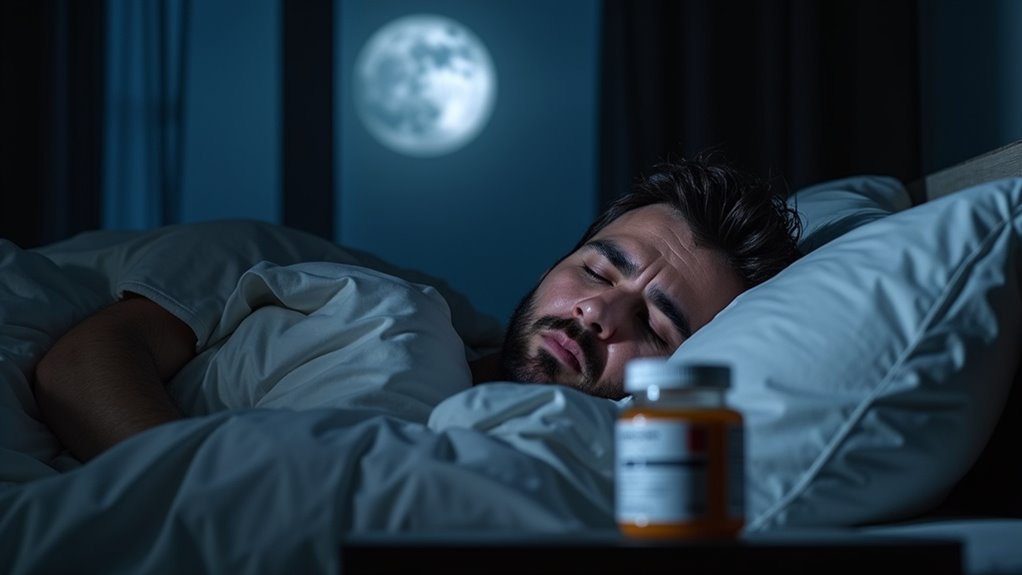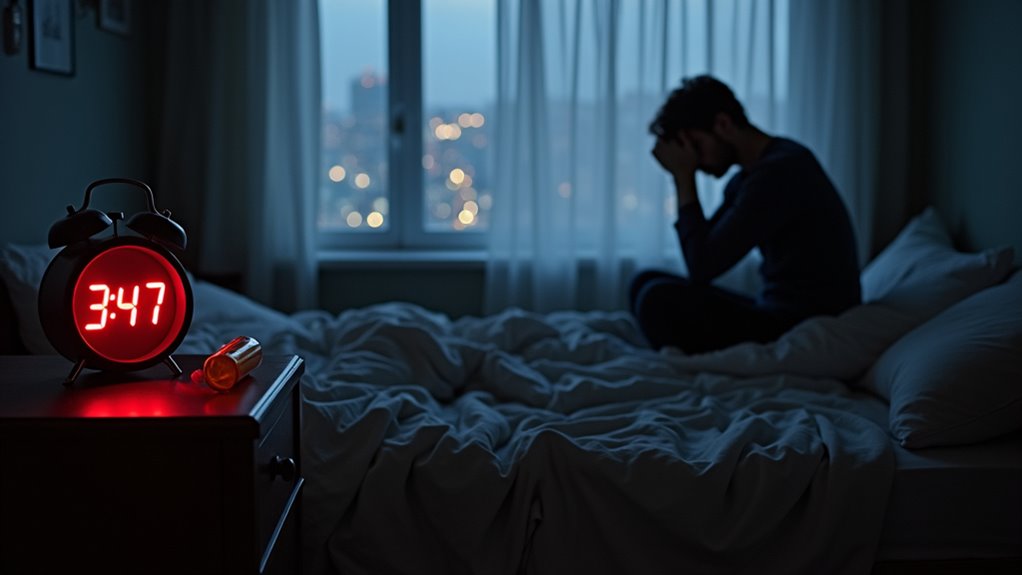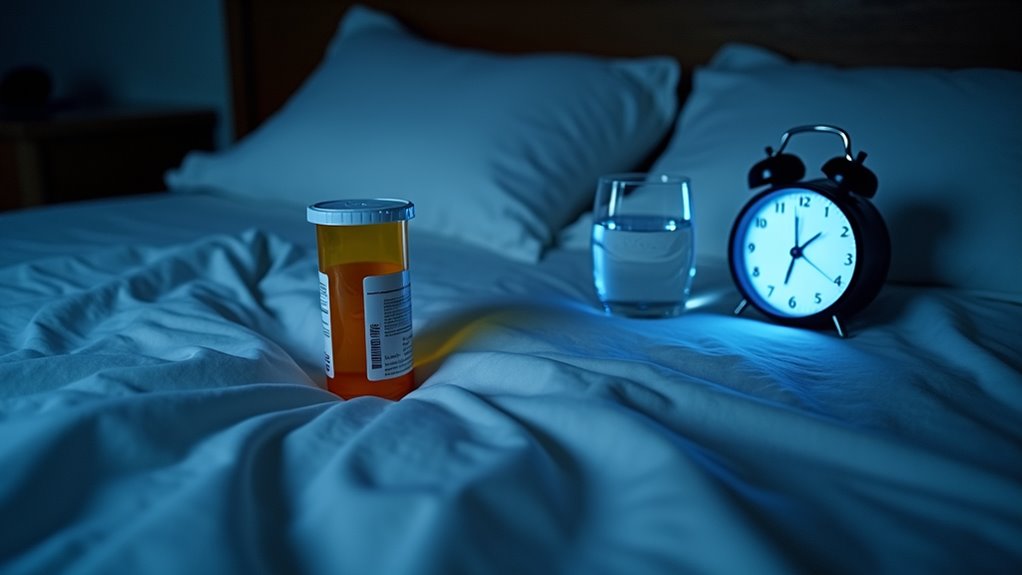Suboxone commonly causes sleep disturbances, affecting up to 70% of users during treatment. You’ll likely experience changes in your sleep patterns, including difficulty falling asleep, increased nighttime awakenings, and reduced quality of rest. The medication disrupts normal sleep architecture by altering brain chemicals like adenosine and affecting opioid receptors that regulate sleep-wake cycles. While these effects are less severe than traditional opioids, understanding the specific mechanisms can help you better manage your treatment path.
Understanding Sleep-Related Side Effects of Suboxone

How does Suboxone affect your sleep patterns? Clinical studies show that approximately 14% of users experience insomnia, while others report significant drowsiness. These effects stem from buprenorphine’s opioid agonist activity, which disrupts normal sleep architecture and reduces pivotal NREM sleep phases. Suboxone has been shown to significantly increase sleep latency, making it harder to fall asleep initially.
These disturbances can affect your long-term recovery contemplations, particularly when combined with anxiety or depression. Research indicates that Suboxone alters adenosine levels, a key neurotransmitter in sleep regulation. The partial opioid agonist properties of Suboxone contribute to sleep disruption by affecting the brain’s natural sleep-wake cycle. Treatment success often depends on incorporating 12-Step programs alongside medication to help manage sleep issues. In addition, medication interactions must be carefully monitored, as co-prescribed drugs may intensify sleep-related side effects.
You’ll likely notice increased wakefulness and potential concentration problems during treatment. When shifting from other opioids, you might experience temporary withdrawal-related sleep disruptions that typically improve as your body adjusts to the treatment.
How Suboxone Disrupts Normal Sleep Patterns

While understanding sleep-related side effects provides context, examining the specific mechanisms of sleep disruption reveals Suboxone’s complex impact on your body’s natural sleep architecture. Buprenorphine’s neurochemical effects directly alter your sleep patterns through adenosine signaling implications in key brain regions, particularly the basal forebrain. The combination of buprenorphine and naloxone makes these sleep effects more manageable compared to full opioid medications.
Your normal sleep structure becomes disrupted in three primary ways:
- Decreased adenosine levels in the substantia innominata reduce your natural sleep drive
- Prolonged wakefulness and delayed sleep onset make it harder to fall asleep
- Reduced slow-wave sleep and increased time in lighter sleep stages diminish sleep quality
These disruptions stem from Suboxone’s interaction with opioid receptors, affecting essential sleep-regulating centers in your brain. The medication’s impact on neurotransmitter balance creates persistent alterations in your sleep-wake cycle regulation. Studies have shown that patients taking buprenorphine tend to experience less slow wave sleep compared to those on other opioid treatments.
The Science Behind Sleep Quality Changes

Multiple neurochemical mechanisms explain Suboxone’s profound impact on sleep quality. As a partial μ-opioid agonist, buprenorphine alters your brain’s natural sleep-wake processes through adenosine signaling dysregulation. This disruption reduces your sleep pressure and increases wakefulness during rest periods.
You’ll experience measurable changes in sleep architecture, including decreased NREM and REM sleep, longer time to fall asleep, and more fragmented sleep cycles. The medication’s effects on κ-opioid receptors contribute to circadian rhythm modulation, further compromising your sleep quality. Research indicates that patients with sleep disturbances have significantly higher odds of developing depression during treatment.
Research shows these disruptions are dose-dependent, with higher amounts typically causing more severe insomnia-like symptoms. Your individual response may vary based on factors like prior opioid exposure, genetic differences, and existing mental health conditions.
Comparing Sleep Effects: Suboxone Vs Traditional Opioids
Traditional opioids’ full agonist effects create more severe disruptions to sleep architecture compared to Suboxone’s partial agonist mechanism. You’ll notice that while both medications can affect sleep, methadone users report markedly higher rates of poor sleep quality (70-85%) than those taking buprenorphine.
Since Suboxone’s unique partial agonist/antagonist properties don’t fully activate opioid receptors, you’re likely to experience less daytime drowsiness and fewer sleep disturbances than with conventional opioids.
Partial Vs Full Agonists
Unlike traditional opioids that act as full agonists, Suboxone’s primary component buprenorphine functions as a partial agonist, creating distinct differences in sleep architecture and disturbance patterns. The receptor specificity of buprenorphine leads to unique neurochemical interactions that affect your sleep-wake cycle differently than full agonists like morphine. The medication’s long-acting nature provides more consistent sleep patterns compared to short-acting opioids.
Key differences between partial and full agonists include:
- Partial agonists have a ceiling effect that limits excessive sedation but may disrupt adenosine signaling
- Full agonists maintain consistent sedative effects, while partial agonists show reduced long-term adaptations
- Partial agonists trigger REM sleep rebounds, unlike full agonists that consistently suppress REM
Your sleep patterns may initially worsen with Suboxone but typically stabilize over time due to its controlled receptor activation, offering better long-term outcomes compared to traditional opioids’ severe sleep disruption. When combined with counseling and behavioral therapies, this stabilization process can help patients better manage both their recovery and sleep challenges.
Sleep Pattern Severity Differences
When comparing sleep disturbances between Suboxone and traditional opioids, significant differences emerge in both severity and manifestation. While Suboxone increases wakefulness by 530% and disrupts sleep architecture alterations through reduced NREM and REM sleep, traditional opioids typically cause daytime sedation and hypersomnia.
Suboxone lengthens the time it takes to fall asleep and increases nighttime awakenings, whereas full opioids may initially decrease sleep latency due to their sedating effects. Both medications cause REM sleep reduction, though traditional opioids potentially suppress REM more intensely due to stronger receptor activation. Particularly, Suboxone’s sleep disruptions often require treatment with medications like eszopiclone, while traditional opioids rarely need specific sleep interventions despite causing fragmentation through respiratory depression.
Research Findings on Sleep Disturbances
Clinical studies show that over 70% of people using Suboxone (buprenorphine) experience significant sleep disturbances, comparable to rates seen in methadone patients. You’ll find strong evidence that these sleep disruptions manifest through increased time spent awake during rest periods and altered sleep onset patterns. Patients with longer treatment duration tend to report fewer sleep problems.
Research indicates these effects are phase-dependent, with users experiencing more wakefulness during typical sleep hours and disrupted shifts between sleep stages. Recent research examining video-observed medication compliance has provided valuable insights into how adherence to prescribed Suboxone dosing schedules may impact sleep patterns.
Clinical Evidence Summary
Research findings consistently demonstrate that Suboxone (buprenorphine/naloxone) greatly impacts sleep architecture and quality across multiple clinical studies. Clinical evidence shows substantial disruptions in both REM and NREM sleep patterns, with patients experiencing prolonged sleep latency and frequent nocturnal awakenings. Sleep deprivation withdrawal symptoms commonly manifest during treatment initiation and dose adjustments. Studies indicate that sleep-disordered breathing is particularly common in patients undergoing maintenance treatment.
Studies indicate reduced sleep quality with measurable decreases in slow-wave sleep and altered REM cycles.
Clinical trials document increased daytime fatigue and excessive sleepiness as common side effects.
Research demonstrates that pharmacological interventions may be necessary to address persistent sleep disturbances.
These sleep disruptions often require medical supervision and targeted management strategies, as they can noticeably impact treatment adherence and overall recovery outcomes.
Sleep Pattern Disruption Rates
Just how prevalent are sleep disturbances among Suboxone users? Research findings show that a striking 71% of patients on buprenorphine (Suboxone) report sleep disruptions, which closely mirrors the rates seen in methadone patients (75-84%). Sleep quality metrics indicate that over two-thirds of users experience significant sleep difficulties.
Sleep cycle monitoring reveals specific disruptions in both NREM and REM sleep patterns. You’ll likely experience increased time spent awake during normal sleep hours, along with fragmented sleep patterns and greater difficulty falling asleep. While these disturbances persist during treatment, they don’t appear to worsen with higher doses unlike methadone. Remarkably, patients with shorter treatment durations (averaging 2.86 years) report more sleep issues, and those with depression may face an elevated risk of sleep problems.
Managing Sleep Issues During Treatment
Managing sleep difficulties while on Suboxone requires a systematic, multi-faceted approach customized to each patient’s needs. You’ll need to work closely with your healthcare provider to develop effective insomnia treatment strategies, especially if you’re experiencing comorbid sleep-related disorders.
Effective sleep management during Suboxone treatment demands personalized strategies and close collaboration with healthcare providers to address complex sleep challenges.
It’s important to remember that Suboxone is a common treatment option despite its potential sleep-related side effects.
Key interventions include:
- Adjusting your Suboxone dosing schedule to align with your natural circadian rhythms
- Tracking sleep patterns through detailed sleep journals to identify triggers
- Addressing underlying mental health conditions, particularly depression or anxiety, which affect 60% of patients with sleep disturbances
If you’re among the 14% experiencing insomnia as a side effect, your healthcare team may recommend specialized interventions. These can include exploring melatonin supplementation under medical supervision or implementing flexible dosing regimens based on your individual tolerance and response patterns.
Frequently Asked Questions
Can I Take Sleep Medications While on Suboxone?
You’ll need direct medical supervision before combining any sleep medications with Suboxone due to potential respiratory risks.
While prescription melatonin may be safer than other sleep aids, you should discuss this option with your healthcare provider.
Start by establishing consistent bedtime routines before considering medications.
If you need sleep support, your doctor can evaluate your individual situation and recommend appropriate solutions that won’t interfere with your Suboxone treatment.
How Long After Taking Suboxone Should I Wait Before Going to Bed?
For ideal timing of Suboxone administration, you’ll want to take your dose at least 6-8 hours before bedtime. This allows the medication’s peak effects to subside, potentially reducing sleep disruptions.
However, factors affecting Suboxone’s sleep impact vary among individuals, including your dosage, metabolism, and personal response. If you’re experiencing sleep issues, try taking it in the morning and maintain a consistent schedule.
Always consult your healthcare provider for personalized timing recommendations.
Will Exercising Before Bedtime Help With Suboxone-Related Sleep Problems?
While you might be tempted to exercise close to bedtime, it’s best to schedule your evening workout routines at least 4-6 hours before sleep. Daytime physical activity is more beneficial, as late workouts can increase alertness when you’re trying to rest.
If you want to move in the evening, stick to gentle activities like stretching or yoga. This approach helps promote relaxation without overstimulating your body during Suboxone treatment.
Does Splitting Suboxone Doses Throughout the Day Improve Sleep Quality?
While there’s no direct clinical evidence that splitting your Suboxone doses improves sleep quality, proper dosage timing adjustments might help stabilize your medication levels throughout the day.
To enhance ideal sublingual absorption, you’ll want to space split doses at least 6-8 hours apart. However, you should never modify your dosing schedule without consulting your healthcare provider, as individual factors considerably influence how this medication affects your sleep patterns.
Are There Specific Foods That Can Help Minimize Suboxone’s Effects on Sleep?
You can support better sleep through strategic food choices that naturally elevate melatonin and serotonin production. Focus on tryptophan-rich foods like turkey, eggs, and pumpkin seeds.
Include dietary magnesium sources such as spinach and dark chocolate to help regulate sleep patterns. Tart cherries and walnuts can amplify your natural melatonin levels.
Avoid caffeine, alcohol, and heavy meals before bedtime, as they’ll interfere with sleep quality.

